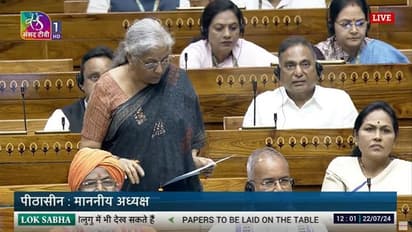India's real GDP projected to grow 6.5% to 7% in 2024-25, Economic Survey reveals | Key highlights

Synopsis
Earlier, a finance ministry report released ahead of the interim Budget for 2024-25, which was presented on February 1, estimated a GDP growth rate close to 7% for the fiscal year. Additionally, in June, the Reserve Bank of India (RBI) adjusted its growth forecast for FY25 upward to 7.2%, up from its previous estimate of 7%.
Union Finance Minister Nirmala Sitharaman on Monday (July 22) tabled the Economic Survey that revealed India's real GDP is expected to grow between 6.5% and 7% in the fiscal year 2024-25. This projection aligns closely with the International Monetary Fund’s estimate of 7%.
Presented a day before Budget announcement, the Economic Survey offers a cautiously optimistic forecast. The survey acknowledges balanced risks and reflects market expectations, noting, "The survey conservatively projects a real GDP growth of 6.5%–7%, aware that market expectations are on the higher side."
Parliament debate intensifies as Rahul Gandhi questions NEET 2024 paper leak claims; check details
Earlier, a finance ministry report released ahead of the interim Budget for 2024-25, which was presented on February 1, estimated a GDP growth rate close to 7% for the fiscal year. Additionally, in June, the Reserve Bank of India (RBI) adjusted its growth forecast for FY25 upward to 7.2%, up from its previous estimate of 7%.
India has experienced growth exceeding 7% over the past three years, highlighting the robustness of its economic trajectory despite global uncertainties. The Economic Survey's forecast reflects a balanced perspective, considering both optimistic and cautious economic scenarios.
Key Highlights of the Economic Survey 2023-24:
1. The Economic Survey 2023-24 projects a conservative real GDP growth of 6.5% to 7% for the fiscal year 2024-25. This forecast considers balanced risks while acknowledging that market expectations might be higher.
2. Both the Reserve Bank of India (RBI) and the International Monetary Fund (IMF) foresee India's consumer price inflation gradually aligning with the inflation target by FY26. Assuming normal monsoon conditions and the absence of additional external or policy shocks, the RBI expects headline inflation to be 4.5% in FY25 and 4.1% in FY26.
3. Remittances to India are projected to grow by 3.7% to reach USD 124 billion in 2024, and by 4% to reach USD 129 billion in 2025.
4. Unhealthy diets account for 54% of the disease burden in India, highlighting the need for a transition towards a balanced and diverse diet.
5. Increased Foreign Direct Investment (FDI) inflows from China can enhance India’s participation in the global supply chain and boost exports.
6. Artificial Intelligence presents significant uncertainty regarding its impact on workers across all skill levels.
7. The short-term inflation outlook remains benign, though India faces persistent deficits in pulses, leading to price pressures.
8. Capital markets are becoming increasingly prominent in India's growth story, showing resilience to global geopolitical and economic shocks.
9. As the financial sector undergoes critical transformation, it must be prepared for potential vulnerabilities from both global and local sources.
10. Governments should consider relinquishing some control to experience the benefits of reduced bureaucratic weight.
11. Tax compliance improvements, expenditure restraint, and digitization have helped India achieve a balanced fiscal management approach.
12. India's banking and financial sectors have shown stellar performance in FY24.
13. The Central Government's policy interventions and the Reserve Bank of India’s price stability measures have maintained retail inflation at 5.4% in FY24, the lowest level since the pandemic.
14. The decrease in retail inflation in FY24 was driven by a fall in core inflation for both goods and services. Core services inflation eased to a nine-year low, and core goods inflation declined to a four-year low in FY24.
Stay updated with the Breaking News Today and Latest News from across India and around the world. Get real-time updates, in-depth analysis, and comprehensive coverage of India News, World News, Indian Defence News, Kerala News, and Karnataka News. From politics to current affairs, follow every major story as it unfolds. Get real-time updates from IMD on major cities weather forecasts, including Rain alerts, Cyclone warnings, and temperature trends. Download the Asianet News Official App from the Android Play Store and iPhone App Store for accurate and timely news updates anytime, anywhere.